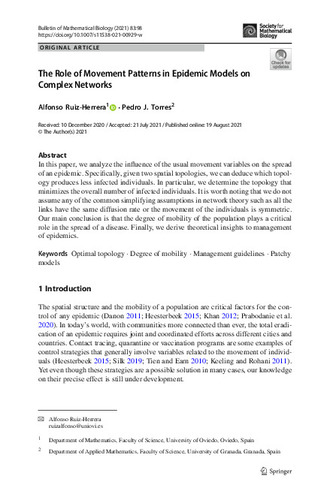The Role of Movement Patterns in Epidemic Models on Complex Networks
Autor(es) y otros:
Fecha de publicación:
Versión del editor:
Citación:
Resumen:
In this paper, we analyze the influence of the usual movement variables on the spread of an epidemic. Specifically, given two spatial topologies, we can deduce which topol- ogy produces less infected individuals. In particular, we determine the topology that minimizes the overall number of infected individuals. It is worth noting that we do not assume any of the common simplifying assumptions in network theory such as all the links have the same diffusion rate or the movement of the individuals is symmetric. Our main conclusion is that the degree of mobility of the population plays a critical role in the spread of a disease. Finally, we derive theoretical insights to management of epidemics.
In this paper, we analyze the influence of the usual movement variables on the spread of an epidemic. Specifically, given two spatial topologies, we can deduce which topol- ogy produces less infected individuals. In particular, we determine the topology that minimizes the overall number of infected individuals. It is worth noting that we do not assume any of the common simplifying assumptions in network theory such as all the links have the same diffusion rate or the movement of the individuals is symmetric. Our main conclusion is that the degree of mobility of the population plays a critical role in the spread of a disease. Finally, we derive theoretical insights to management of epidemics.
Notas Locales:
OA ATUO21
Patrocinado por:
Funding was provided by Ministry of Science and Technology (MTM2017-364758).
Colecciones
- Artículos [37548]
- Investigaciones y Documentos OpenAIRE [8420]
- Matemáticas [326]
Ficheros en el ítem





